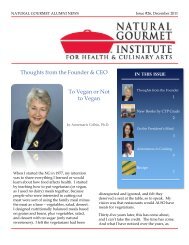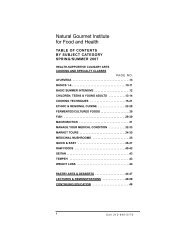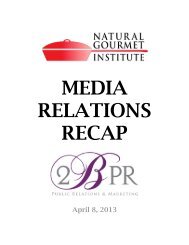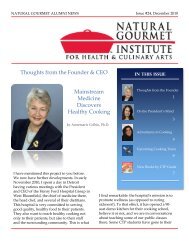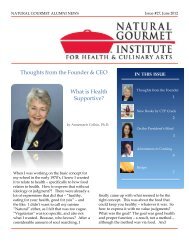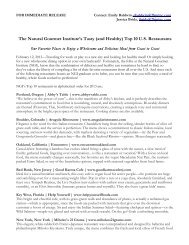Alumni Newsletter -- Jul '09 (PDF) - The Natural Gourmet Institute
Alumni Newsletter -- Jul '09 (PDF) - The Natural Gourmet Institute
Alumni Newsletter -- Jul '09 (PDF) - The Natural Gourmet Institute
You also want an ePaper? Increase the reach of your titles
YUMPU automatically turns print PDFs into web optimized ePapers that Google loves.
does this kind of work for people, always says, “when<br />
you throw out the old, you make room for the new.”<br />
In my own experience, I found it really true that you<br />
can change your life by tossing out stuff you don’t<br />
need anymore. I have often worked with people who<br />
specialize in clutter cleaning, as I myself often am<br />
too attached to my old stuff. But I’m getting better –<br />
you should see how much I’m tossing and shredding.<br />
I know that some people have trouble throwing<br />
out stuff – who knows, maybe they’ll need it again, or<br />
they’ll find they need it right after the garbage truck<br />
made off with it. Heaven forfend! But the truth is,<br />
that hardly ever happens. And if you REALLY need<br />
it again, just buy a new one.<br />
Of course, the stuff I’m going through cannot<br />
be bought. It’s memories, mementoes, records of old<br />
ideas, lots of old versions of recipes. But I’ve learned<br />
over the years that recipes can be re-done, reinvented,<br />
and updated a million times. I don’t need<br />
to keep those old ones. Besides, most of them are<br />
in my books, if they were any good. And do I really<br />
need to hold on to those old class notes? What would<br />
I use them for? Truth is, I never do.<br />
And speaking of new things, the NGI is trying<br />
hard to join the current digital culture. We now have<br />
a presence both on Facebook and on Twitter. People<br />
who know about this stuff think we’re doing great<br />
with it. I’m pleased as well. Check it out!<br />
ON THE PRESIDENT’S MIND<br />
by Jenny Matthau<br />
MY TRIP OUT WEST<br />
Last November I<br />
made my yearly<br />
sojourn to the Weston A.<br />
Price Foundation’s Wise<br />
Traditions Conference.<br />
It was the first time the<br />
Conference was held on<br />
the West Coast, near San<br />
Francisco.<br />
I heard many fascinating lectures, but was<br />
most interested in the three focusing on iodine<br />
deficiency and its relationship to thyroid disorders,<br />
fibrocystic breast disease, breast cancer and many<br />
other health problems, including, but not limited to<br />
adrenal dysfunction, depression, chronic infections<br />
and all hormonally mediated cancers.<br />
<strong>The</strong> first speaker was Lynne Farrow, MA,<br />
a former college professor, journalist and editor<br />
who currently serves as Director of the nonprofit<br />
research and advocacy organization, Breast Cancer<br />
Choices. This organization has been conducting<br />
a database study called <strong>The</strong> Iodine Investigation<br />
Project which follows women using iodine as part<br />
of their treatment for breast disease, especially<br />
breast cancer. <strong>The</strong> main theme of Lynne’s talk<br />
was that many people in the U.S. are deficient in<br />
iodine today, resulting in much higher incidence<br />
of breast cancer compared to thirty years ago. In<br />
the 1970’s, manufacturers stopped adding iodine<br />
to flour and replaced it with bromide, which<br />
contributed to widespread deficiency. An endocrine<br />
disruptor and neurotoxin, bromide is used as a fire<br />
retardant in the form of PBDE’s (polybrominated<br />
diphenyls) and can be found in furniture, iPhones,<br />
stuffed animals, mattresses, clothing, computers<br />
and cars (responsible for “new car smell”). Bromide<br />
greatly increases our bodies’ iodine requirement,<br />
which when combined with iodine insufficiency<br />
and aging, creates “the perfect storm,” meaning<br />
that this confluence of factors greatly increases<br />
susceptibility to breast cancer. Lynne presented<br />
evidence that iodine protects against breast cysts<br />
and breast cancer and that the two conditions are<br />
closely related. (Dr. Robert Bard who practices in<br />
NYC recently told me that research has confirmed<br />
that women who have fibrocystic breast disease<br />
are 5 to 7 times more likely to develop breast<br />
cancer.) To find out more, visit Lynne’s website at:<br />
www.breastcancerchoices.org.<br />
<strong>The</strong> second speaker was Dr. Janet R. Lang,<br />
a chiropractor who in addition to seeing patients,<br />
conducts ongoing clinical research and teaches<br />
professional Functional Endocrinology seminars<br />
across the U.S. She is the author of Understanding<br />
the Peripheral Nervous System and a contributing<br />
author of <strong>The</strong> Heart of the Healer. Dr. Lang<br />
explained that the RDA for iodine in the United<br />
States (150 mcg) was based on the amount needed<br />
to prevent goiter and cretinism, but falls woefully<br />
short of the amount needed to prevent thyroid,<br />
breast and many other disorders. She recommended<br />
adding kelp to our diets, but acknowledged that<br />
supplementation is necessary for many individuals.<br />
She also maintained that when iodine loading, one<br />
needs to increase intakes of selenium, magnesium<br />
and essential fatty acids. Her website is:<br />
www.drjlang.com.<br />
<strong>The</strong> third speaker was David Brownstein, MD,<br />
Medical Director of the Center for Holistic Medicine<br />
in Michigan. He is the author of 8 books, covering<br />
a wide array of topics, including iodine, thyroid<br />
disorders, arthritis, natural therapies, gluten-free<br />
<strong>Natural</strong> <strong>Gourmet</strong> <strong>Alumni</strong> News<br />
2





